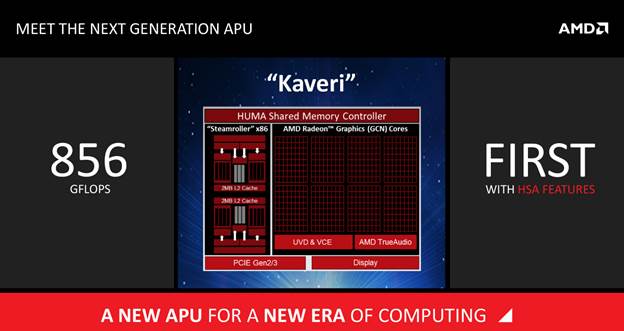APUs like KAVERI are the future for AMD, Reckons Jeremy
Laird, and there are already plenty of compatible motherboards to choose from.
For starters,
Kaveri marks the beginning of a new approach to computing for AMD, and maybe
the PC in general. The buzz term here is HSA, or Heterogeneous System
Architecture. We’ve been through this in PCFs passim, but the basic idea is the
ability for software to run in parallel and seamlessly across both the CPU and
GPU. The details involve unified memory access for CPU and GPU, and essentially
pushing serial work through the CPU and parallel through the GPU. We’ve been
banging on about the concept for years, but AMD has finally built the requisite
hardware.

HSA
creates an improved processor design that exposes the benefits and capabilities
of mainstream programmable compute elements, working together seamlessly.
Then there’s
AMD’s GCN graphics technology, which has been integrated into a CPU for the
first time. Both the Xbox One and the PlayStation 4 use GCN, and it’s also the
graphics architecture that enables AMD’s Mantle API, which promises to
massively reduce CPU overheads in-game.
Oh, and let’s
not forget the whole Steambox thing and the consolification of the PC as a
games device. Does that mean a smallish, power efficient PC that’s gaming
capable, or a truly thin client PC that is merely the target device for a video
stream generated on a traditional big-iron desktop? Clearly, this is a pretty
complex overall narrative, but the implications all point towards Kaveri being
much more significant than the mere disappointment of the Steamroller CPU
architecture.
Jargon
explained
HSA The idea
of Heterogenous System Architecture is to have one chip with lots of
specialised units within. So instead of some general-purpose CPU cores, you
have a 3D graphics core, a 2D video and encode core, and maybe some crypto
functionality. Dedicated hardware typically performs far faster than general-purpose
CPU cores. The really clever bit is making this invisible to software, and
having the code run on the most suitable part of the chip
Priorities
All of that
also puts a slightly different spin on the subject of motherboard platforms for
Kaveri chips. For the most part, the same remit and the same metrics apply, but
the emphasis and the balance of priorities look a little different – at least
for some usages.
Suddenly,
form factor becomes one of the biggies. Kaveri isn’t necessarily a bad choice
for a conventional tower PC. But neither is it a particularly obvious choice.
Instead, it is perhaps the perfect processor pick for almost everything except
a traditional performance PC tower. Full-sized ATX rig on a super-tight budget?
Yup. Puny mini-ITX box that still packs a punch? For sure. Something in between
that deftly balances cost, proportions and performance? Definitely. With that
in mind, there are a few more minor features that are suddenly looking more
critical. An mSATA slot certainly looks attractive when space is at a premium,
for instance. The same goes for integrated Wi-Fi.

The
popularity of mSATA SSDs is probably one of the more unexpected SSD trends to
show its face and, even today, e-tailers just can’t seem to keep mSATA SSDs in
stock.
Equally,
there are items that fall off the radar a little. Is outright overclocking
ability critical? Probably not. Do we want to see debug ports, onboard power
switches or voltage checkpoints? Not necessarily.
That’s not to
say that all the enthusiast-class clobber is instantly redundant. We have a mix
of Kaveri-compatible boards on test this month that span the full spectrum –
including a mini-ITX and a full ATX. It is more a question of weighing up the
value of such features a little differently.

Kaveri-based
desktop system on display at CES 2014.
Now we’ve
covered some of the broader issues to think about with a Kaveri-based system,
what about the specifics such as chipsets? Here, it has to be said, it’s hard
to imagine AMD being much more opaque. Long gone are the days of bigging up
chipsets when it comes to APUs like Kaveri.